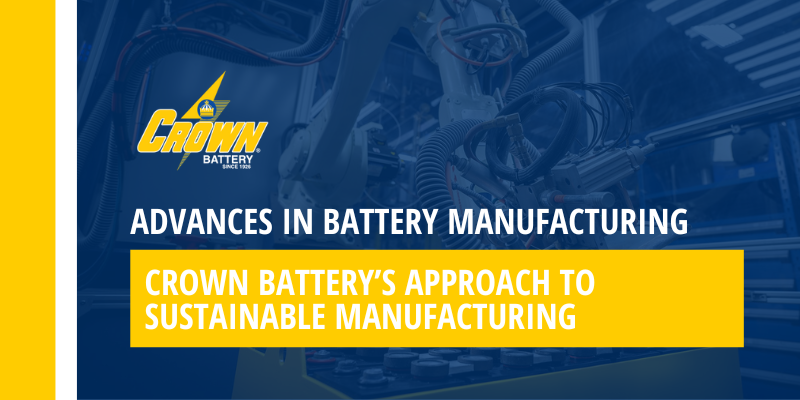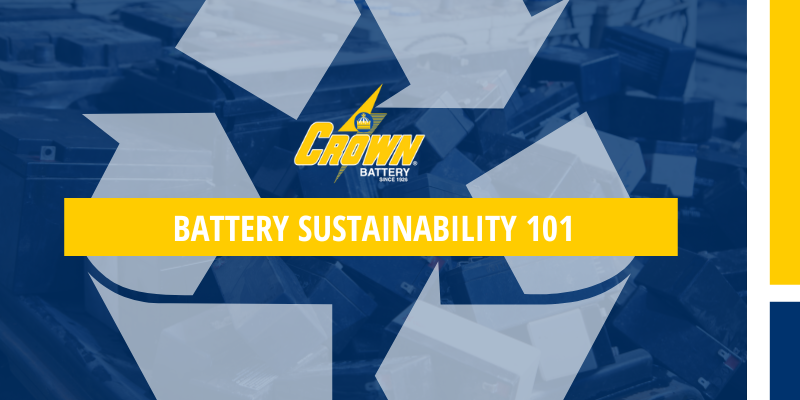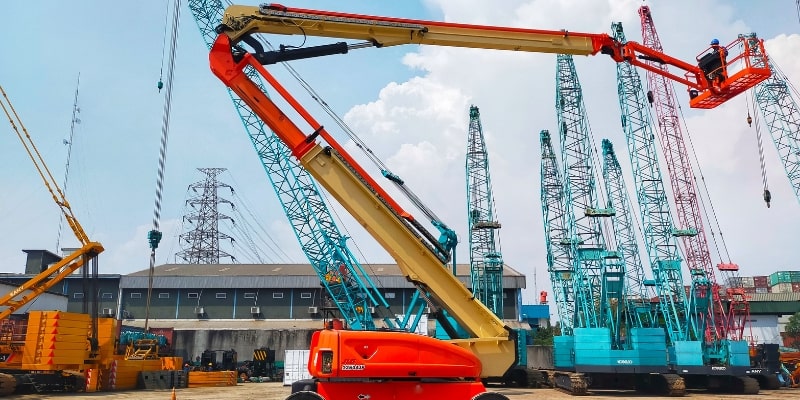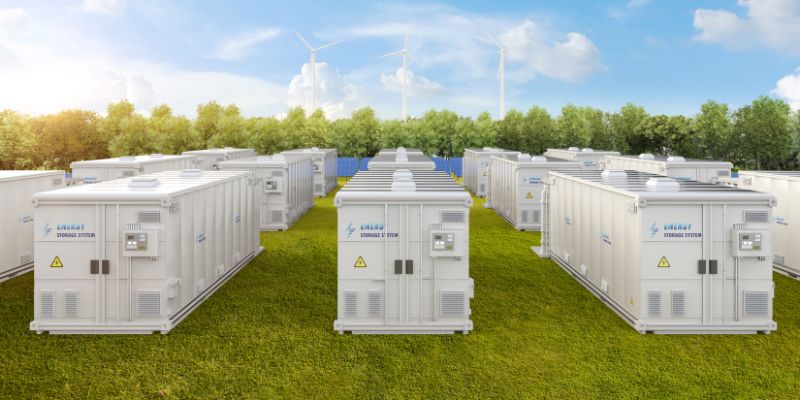Some battery manufacturers still use 20th-century techniques. Here’s how Crown’s manufacturing advances improve battery life, reliability, and ROI – and reduce your environmental footprint:
Last-generation Manufacturing: Many battery manufacturers use manual welding – and tired workers hold a hot, open flame.
Advanced Manufacturing: Crown Battery’s proprietary Cast-on-Strap (COS) robot fluxes battery plates and lead lugs simultaneously at a computer-controlled temperature.
COS allows for 3,960 more adjustments. And there are no weak points, cold or hot spots, or incomplete burns.
And that’s just one difference – conveniently left out of many battery brochures.
In the next few minutes, you’ll discover how Crown’s advances in sustainable manufacturing benefit you, including:
- How to avoid landfilled batteries – and hidden disposal costs
- What is “Hybrid” R&D, and how does it improve battery life?
- Robotic Assembly 101: Boosting quality and longevity
- Aerospace vision systems + X = Less human error
- And more
1) Choose recyclable batteries – not landfillable ones
Battery recyclability is a keystone of sustainable manufacturing.
Lead-acid and absorbent glass mat (AGM) batteries like Crown’s are 99% recycled – more than an aluminum can (source: US EPA: Advancing Sustainable Materials Management: 2018 Fact Sheet).
And Crown builds batteries using roughly 80% recycled materials. Our on-site equipment refines these raw materials so they’re as pure as virgin-mined – while reducing waste and improving your supply chain reliability.
Industrywide manufacturing, collection, and recycling technologies and infrastructure help Crown Battery create a circular product – and that means far less waste and virgin mining. Because lead-based battery recycling is profitable, you won’t be saddled with sky-high disposal costs.
In comparison, just 5% of lithium-ion batteries are collected for recycling (source: Chemical & Engineering News: It's time to get serious about recycling lithium-ion batteries).
2) Advanced R&D integrates 3D modeling and 3D printing
In the past, batteries were designed entirely in the physical world. That limited how quickly you could improve products and test new ideas.
Today at Crown, we use hybrid R&D and engineering to combine the best of digital and hands-on development methods.
Crown’s 3D modeling helps us develop proof of concept faster. We can brainstorm and integrate more ideas to see what works before we narrow our focus on a single design variation or element for a new product.
When we build test batteries or repair parts for our manufacturing equipment, we use 3D printing to create parts faster and more precisely. That way, we don’t have to wait weeks to get test parts back from a CNC shop before discovering whether they work.
Hybrid digital/analog engineering means Crown engineers can test more promising ideas, more thoroughly – and design better batteries faster.
3) Robotic assembly improves quality and longevity
Assembling batteries using robots alongside trained technicians makes products more consistent and longer-lasting. It also reduces waste.
At Crown Battery, we already use robotics for production stages that benefit the most from automation… especially where humans cannot perform as precisely or where automation improves safety and quality.
For instance, Crown batteries benefit from robotics in:
- Computerized pasting and mixing, which optimizes dozens of variables to improve storage capacity
- Gravity-casting ensures energy-storing plates (metal lattices) last longer… because impurities float to the top.
- 3D-wrapped separators insulate internal components… and help prevent the #1 cause of battery failure, short-circuiting.
Critically, our Cast-On-Strap (COS) delivers 3,960 more adjustments than conventional welding – and eliminates common failure points
If you had x-ray vision and peered inside a recyclable lead-acid or AGM battery…
… you’d see metal lattices that we call plates. These plates have engineered voids that hold a paste; this paste includes recyclable lead and stores chemical energy.
To simplify things: If you want to add capacity, you add more plates – and weld them together.
But there’s an old way and a modern way to connect them.
Many companies still use conventional strap processes invented over 50 years ago:
Workers manually attach lead lugs to a strap, then burn them together by hand, one by one, using a hot open flame. Hand-burnt straps have weaker connection points burnt at inconsistent temperatures - and they aren’t as safe for workers, either.
Crown’s proprietary COS machinery fluxes battery plates and lead lugs automatically. There are no weak points, cold or hot spots, or incomplete burns.
COS ensures consistent, low electrical-resistance welds to strengthen connections, resist cracking, and improve battery life.
Properly integrating COS can be expensive and time-consuming. Make sure your battery manufacturer has had enough time to refine its COS system and work out kinks. And confirm that your battery undergoes additional quality control checks.
Crown Battery spent over a decade refining its COS process, and our multi-stage quality controls include several vision systems and multiple hand inspections.
4) Aerospace vision systems + 250-point Quality Inspection = Less human error
Inspections protect your investment and maximize longevity before recycling.
Ideally, every manufacturer should eliminate all possible causes of human error that reduce product quality and consistency.
For instance, Crown’s vision systems use image capturing and AI-powered software interpretation to inspect parts automatically.
Vision systems never get tired.
They spot defects humans can miss.
Because they exceed stringent quality control standards – when combined with hand inspection – vision systems are used throughout high-tech industries such as microprocessor manufacturing.
Vision systems are relatively rare in the battery industry because of their higher initial cost and demanding installation requirements.
Crown’s vision systems monitor several critical stages of manufacturing.
For example, before COS, a vision system scans and counts the lugs to ensure they are loaded correctly. Plates are rechecked after the machine aligns them. Another vision system confirms that cells were correctly loaded into the battery to ensure uniformity.
Trained technicians relentlessly test Crown batteries to ensure their viability in any system.
Experts closely monitor and inspect production equipment and batteries – to ensure quality and consistency.
We’ve also installed thousands of test batteries in brutal operating conditions across the continent, including mines and factories. As part of our R&D and improvement process, we digitally monitor, chemically analyze, and tear down these test batteries.
Every Crown battery meets or exceeds Battery Council International (BCI) and International Electrotechnical Commission (IEC) test standards. We also use on-site chemical, electrochemical, teardown, analytical, and evaluation labs, along with a leading independent testing lab – to constantly analyze, improve, and create new products.
Crown tests batteries directly from our production line as part of our rigorous development and production cycle that includes:
- Chemical/Titration analysis for chemical compound ratios
- Autopsies and diagnostics of test batteries
- Measurement with reference electrodes to study positive and negative electrodes
- 300 x-ray diffraction tests per month
- Scanning electron microscope (SEM) inspection
5) Renewable energy for manufacturing
Crown Battery sources renewable energy for manufacturing…
… and is the battery industry’s first US EPA Green Power Partner.
 One of the easiest ways to improve sustainability is to manufacture batteries with near-zero-carbon electricity from renewables (e.g. solar and wind) or fission power.
One of the easiest ways to improve sustainability is to manufacture batteries with near-zero-carbon electricity from renewables (e.g. solar and wind) or fission power.
Crown Battery supports local solar and wind power through our power company's Integrated Renewable Energy (IRE) solution.
Sourcing renewable energy in manufacturing means every Crown battery pollutes less, supports energy independence and resilience, and reduces your carbon footprint.
What’s next:
Ask your current battery manufacturer how they make their batteries. And use this blog post to help you comparison shop.
Because advanced engineering and manufacturing will improve your sustainability and battery life – and boost your uptime.





